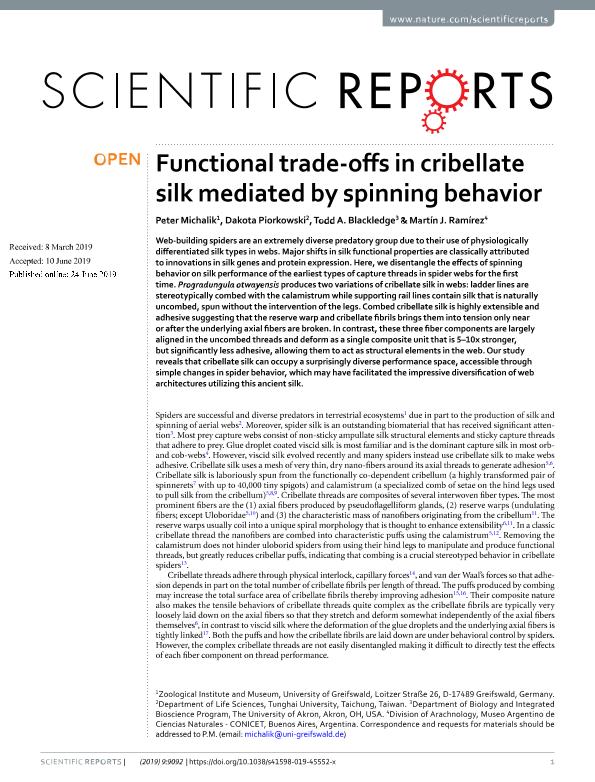Artículo
Functional trade-offs in cribellate silk mediated by spinning behavior
Fecha de publicación:
12/2019
Editorial:
Nature Publishing Group
Revista:
Scientific Reports
e-ISSN:
2045-2322
Idioma:
Inglés
Tipo de recurso:
Artículo publicado
Clasificación temática:
Resumen
Web-building spiders are an extremely diverse predatory group due to their use of physiologically differentiated silk types in webs. Major shifts in silk functional properties are classically attributed to innovations in silk genes and protein expression. Here, we disentangle the effects of spinning behavior on silk performance of the earliest types of capture threads in spider webs for the first time. Progradungula otwayensis produces two variations of cribellate silk in webs: ladder lines are stereotypically combed with the calamistrum while supporting rail lines contain silk that is naturally uncombed, spun without the intervention of the legs. Combed cribellate silk is highly extensible and adhesive suggesting that the reserve warp and cribellate fibrils brings them into tension only near or after the underlying axial fibers are broken. In contrast, these three fiber components are largely aligned in the uncombed threads and deform as a single composite unit that is 5–10x stronger, but significantly less adhesive, allowing them to act as structural elements in the web. Our study reveals that cribellate silk can occupy a surprisingly diverse performance space, accessible through simple changes in spider behavior, which may have facilitated the impressive diversification of web architectures utilizing this ancient silk.
Palabras clave:
Silk
,
Material sciences
,
Behavior
Archivos asociados
Licencia
Identificadores
Colecciones
Articulos(MACNBR)
Articulos de MUSEO ARG.DE CS.NAT "BERNARDINO RIVADAVIA"
Articulos de MUSEO ARG.DE CS.NAT "BERNARDINO RIVADAVIA"
Citación
Michalik, Peter; Piorkowski, Dakota; Blackledge, Todd A.; Ramirez, Martin Javier; Functional trade-offs in cribellate silk mediated by spinning behavior; Nature Publishing Group; Scientific Reports; 9; 1; 12-2019; 1-6
Compartir
Altmétricas




